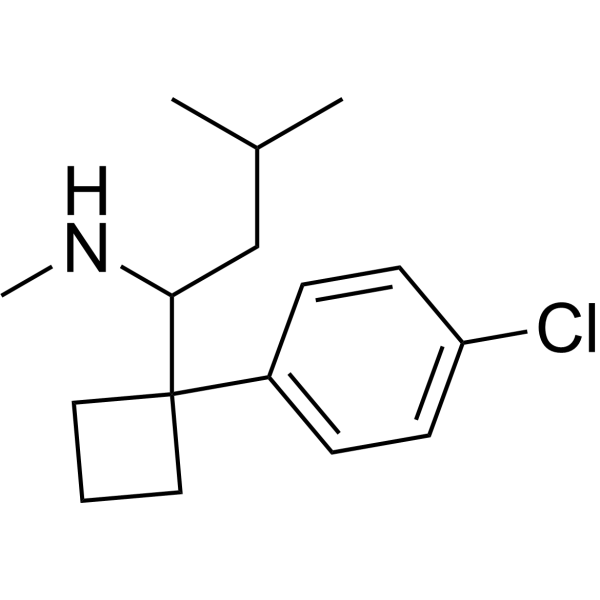
| 规格 | 价格 | 库存 | 数量 |
|---|---|---|---|
| 5mg |
|
||
| Other Sizes |
|
| 靶点 |
NET and SERT[1]
|
|---|---|
| 体外研究 (In Vitro) |
开发了一种液相色谱-电喷雾电离质谱(LC-ESI-MS)方法,用于同时测定六种合成掺杂物,即芬氟拉明、酚酞、N-二去甲基西布曲明、N-单去甲基西布曲明和奥利司他。该方法被应用于分析草药减肥膳食补充剂。使用溶剂a:乙腈和溶剂B:20mM甲酸铵水溶液的梯度洗脱,在C(8)反相柱上实现了分析物的色谱分离。西地那非被用作定量的内标。质谱检测器在正电喷雾电离模式下运行。对m/z 232、319、252、266、280、496和475分别进行了芬氟拉明、酚酞、N-二甲基西布曲明、N-单甲基西布曲明、西布曲明、奥利司他和西地那非的选择性离子监测(SIM)。该方法的准确度、精密度、线性和选择性得到了验证。六种合成掺杂物的检测限范围为0.0018至0.73微克/克(-1)。所提出的方法用于对22种膳食补充剂进行小型调查,其中11种样品掺入了酚酞、N-单脱甲基西布曲明和西布曲明,掺入量为0.212至96.2 mg g(-1)[3]。
|
| 酶活实验 |
西布曲明是一种中枢作用的单胺再摄取抑制剂,在肥胖管理中被用作食欲抑制剂。其作用主要归因于血清素和去甲肾上腺素转运体(分别为SERT和NET)对其强效代谢产物去甲基西布曲明(M1)和去甲基西布曲明的抑制。然而,关于临床疗效和少数患者观察到的剂量无关无反应的机制,人体体内数据很少。12名健康男性患者(平均年龄41岁)完成了一项双盲、安慰剂对照、受试者内交叉研究,研究稳定状态下每天服用15mg西布曲明对大脑SERT的占用情况。测量了占用率与(i)西布曲明、M1和M2的血浆浓度之间的相关性;(ii)食欲抑制。(11) 在HRRT相机上进行C-DASB PET扫描。结合电位(BP(ND))通过Logan参考组织(小脑)方法计算。SERT占用率适中(平均30+/-10%),各脑区相似,但受试者之间差异很大(15-46%)。占用率与M2浓度呈正相关(p=0.09),但与西布曲明或M1无关。在<25%的入住率下没有明显的食欲抑制,最大的抑制与最高入住率(25-46%)有关。然而,一些占用率较高(36-39%)的受试者没有食欲抑制。临床剂量西布曲明对SERT的占用程度适中,可能主要由M2介导。5-羟色胺再摄取抑制可能是必要的,但对于西布曲明在人体中的疗效来说还不够,支持临床前数据表明,低剂量效应需要SERT和NET的共同抑制[1]。
|
| 药代性质 (ADME/PK) |
Metabolism / Metabolites
Desmethylsibutramine is a known human metabolite of (S)-Sibutramine. |
| 参考文献 |
|
| 其他信息 |
Sibutramine HCl is an inhibitor of the reuptake of monoamines with a pharmacological profile in rodents indicative of antidepressant activity. The secondary (BTS 54 354) and primary (BTS 54 505) amine metabolites of the tertiary amine sibutramine HCl exhibit similar in vivo pharmacological activity to the parent compound. Thus, each compound displays potent activity in acute behavioural models predictive of antidepressant effects and a comparable ability to inhibit the uptake of monoamines in vivo. In addition, BTS 54 354 and BTS 54 505 induce an equally rapid and potent down-regulation of cortical beta-adrenoceptors in the rat as sibutramine HCl. The secondary and primary amines are, however, considerably more active than sibutramine HCl as inhibitors of the uptake of noradrenaline, dopamine and 5-hydroxytryptamine in vitro. The potent inhibition of the reuptake of noradrenaline by the secondary and primary amine metabolites probably contributes to the rapid and potent down-regulation of beta-adrenoceptors in the rat, induced by the putative antidepressant sibutramine HCl.[2]
Obesity can be considered as a chronic illness of epidemic proportion and its incidents have increased exponentially in recent years. The use of anti-obesity drugs such as sibutramine is somewhat helpful. There is a need to quantify such drugs in biological samples, which is generally quite difficult. In this report, we developed and validated a simple, sensitive and specific liquid chromatography-tandem mass spectrometry (LC-MS/MS) method for the quantification of sibutramine (SB) and its two metabolites N-des methyl sibutramine (DSB) and N-di desmethyl sibutramine (DDSB) in human plasma. Zorbax SB-C18 (4.6 mm×75 mm, 3.5 μm, 80 Å) analytical column and 5 mM ammonium formate:acetonitrile (10:90, v/v) mobile phase were used for chromatographic separation of SB, DSB and DDSB. Multiple reaction monitoring (MRM) in the positive mode was used to detect SB, DSB and DDSB at m/z 280.3/124.9, 266.3/125.3 and 252.2/124.9, respectively. Liquid-liquid extraction was used for the extraction of analytes and internal standard from human plasma. This method was validated over a linear concentration range of 10.0-10,000.0 pg/mL for SB, DSB and DDSB with correlation coefficients (r) of ≥0.9997. The drug and the two metabolites were stable in plasma samples. The validated method was successfully applied in a bioequivalence and pharmacokinetic study with human volunteers under fasting condition.[4] |
| 分子式 |
C16H24CLN
|
|---|---|
| 分子量 |
265.82
|
| 精确质量 |
265.16
|
| CAS号 |
168835-59-4
|
| 相关CAS号 |
Desmethyl Sibutramine hydrochloride;84467-94-7
|
| PubChem CID |
10199199
|
| 外观&性状 |
White to off-white solid powder
|
| LogP |
4.786
|
| tPSA |
12.03
|
| 氢键供体(HBD)数目 |
1
|
| 氢键受体(HBA)数目 |
1
|
| 可旋转键数目(RBC) |
5
|
| 重原子数目 |
18
|
| 分子复杂度/Complexity |
252
|
| 定义原子立体中心数目 |
0
|
| InChi Key |
PLXKZKLXYHLWHR-UHFFFAOYSA-N
|
| InChi Code |
InChI=1S/C16H24ClN/c1-12(2)11-15(18-3)16(9-4-10-16)13-5-7-14(17)8-6-13/h5-8,12,15,18H,4,9-11H2,1-3H3
|
| 化学名 |
1-[1-(4-chlorophenyl)cyclobutyl]-N,3-dimethylbutan-1-amine
|
| 别名 |
Desmethylsibutramine; Desmethyl Sibutramine; 168835-59-4; N-Desmethylsibutramine; 1-[1-(4-chlorophenyl)cyclobutyl]-N,3-dimethylbutan-1-amine; 889I657R9P; {1-[1-(4-chlorophenyl)cyclobutyl]-3-methylbutyl}(methyl)amine; Desmethyl Sibutramine (hydrochloride);
|
| HS Tariff Code |
2934.99.9001
|
| 存储方式 |
Powder -20°C 3 years 4°C 2 years In solvent -80°C 6 months -20°C 1 month |
| 运输条件 |
Room temperature (This product is stable at ambient temperature for a few days during ordinary shipping and time spent in Customs)
|
| 溶解度 (体外实验) |
May dissolve in DMSO (in most cases), if not, try other solvents such as H2O, Ethanol, or DMF with a minute amount of products to avoid loss of samples
|
|---|---|
| 溶解度 (体内实验) |
注意: 如下所列的是一些常用的体内动物实验溶解配方,主要用于溶解难溶或不溶于水的产品(水溶度<1 mg/mL)。 建议您先取少量样品进行尝试,如该配方可行,再根据实验需求增加样品量。
注射用配方
注射用配方1: DMSO : Tween 80: Saline = 10 : 5 : 85 (如: 100 μL DMSO → 50 μL Tween 80 → 850 μL Saline)(IP/IV/IM/SC等) *生理盐水/Saline的制备:将0.9g氯化钠/NaCl溶解在100 mL ddH ₂ O中,得到澄清溶液。 注射用配方 2: DMSO : PEG300 :Tween 80 : Saline = 10 : 40 : 5 : 45 (如: 100 μL DMSO → 400 μL PEG300 → 50 μL Tween 80 → 450 μL Saline) 注射用配方 3: DMSO : Corn oil = 10 : 90 (如: 100 μL DMSO → 900 μL Corn oil) 示例: 以注射用配方 3 (DMSO : Corn oil = 10 : 90) 为例说明, 如果要配制 1 mL 2.5 mg/mL的工作液, 您可以取 100 μL 25 mg/mL 澄清的 DMSO 储备液,加到 900 μL Corn oil/玉米油中, 混合均匀。 View More
注射用配方 4: DMSO : 20% SBE-β-CD in Saline = 10 : 90 [如:100 μL DMSO → 900 μL (20% SBE-β-CD in Saline)] 口服配方
口服配方 1: 悬浮于0.5% CMC Na (羧甲基纤维素钠) 口服配方 2: 悬浮于0.5% Carboxymethyl cellulose (羧甲基纤维素) 示例: 以口服配方 1 (悬浮于 0.5% CMC Na)为例说明, 如果要配制 100 mL 2.5 mg/mL 的工作液, 您可以先取0.5g CMC Na并将其溶解于100mL ddH2O中,得到0.5%CMC-Na澄清溶液;然后将250 mg待测化合物加到100 mL前述 0.5%CMC Na溶液中,得到悬浮液。 View More
口服配方 3: 溶解于 PEG400 (聚乙二醇400) 请根据您的实验动物和给药方式选择适当的溶解配方/方案: 1、请先配制澄清的储备液(如:用DMSO配置50 或 100 mg/mL母液(储备液)); 2、取适量母液,按从左到右的顺序依次添加助溶剂,澄清后再加入下一助溶剂。以 下列配方为例说明 (注意此配方只用于说明,并不一定代表此产品 的实际溶解配方): 10% DMSO → 40% PEG300 → 5% Tween-80 → 45% ddH2O (或 saline); 假设最终工作液的体积为 1 mL, 浓度为5 mg/mL: 取 100 μL 50 mg/mL 的澄清 DMSO 储备液加到 400 μL PEG300 中,混合均匀/澄清;向上述体系中加入50 μL Tween-80,混合均匀/澄清;然后继续加入450 μL ddH2O (或 saline)定容至 1 mL; 3、溶剂前显示的百分比是指该溶剂在最终溶液/工作液中的体积所占比例; 4、 如产品在配制过程中出现沉淀/析出,可通过加热(≤50℃)或超声的方式助溶; 5、为保证最佳实验结果,工作液请现配现用! 6、如不确定怎么将母液配置成体内动物实验的工作液,请查看说明书或联系我们; 7、 以上所有助溶剂都可在 Invivochem.cn网站购买。 |
| 制备储备液 | 1 mg | 5 mg | 10 mg | |
| 1 mM | 3.7619 mL | 18.8097 mL | 37.6194 mL | |
| 5 mM | 0.7524 mL | 3.7619 mL | 7.5239 mL | |
| 10 mM | 0.3762 mL | 1.8810 mL | 3.7619 mL |
1、根据实验需要选择合适的溶剂配制储备液 (母液):对于大多数产品,InvivoChem推荐用DMSO配置母液 (比如:5、10、20mM或者10、20、50 mg/mL浓度),个别水溶性高的产品可直接溶于水。产品在DMSO 、水或其他溶剂中的具体溶解度详见上”溶解度 (体外)”部分;
2、如果您找不到您想要的溶解度信息,或者很难将产品溶解在溶液中,请联系我们;
3、建议使用下列计算器进行相关计算(摩尔浓度计算器、稀释计算器、分子量计算器、重组计算器等);
4、母液配好之后,将其分装到常规用量,并储存在-20°C或-80°C,尽量减少反复冻融循环。
计算结果:
工作液浓度: mg/mL;
DMSO母液配制方法: mg 药物溶于 μL DMSO溶液(母液浓度 mg/mL)。如该浓度超过该批次药物DMSO溶解度,请首先与我们联系。
体内配方配制方法:取 μL DMSO母液,加入 μL PEG300,混匀澄清后加入μL Tween 80,混匀澄清后加入 μL ddH2O,混匀澄清。
(1) 请确保溶液澄清之后,再加入下一种溶剂 (助溶剂) 。可利用涡旋、超声或水浴加热等方法助溶;
(2) 一定要按顺序加入溶剂 (助溶剂) 。